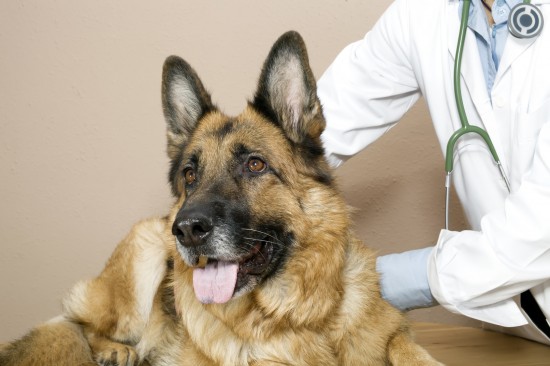

Mast cell tumours are one of the most commonly occurring malignant cancers in dogs, with around 25% of all skin tumours in dogs being of the mast cell type. Mast cell tumours can vary greatly in their appearance from case to case, although usually one tumour is found on its own initially, rather than them proliferating in clusters. Mast cell tumours can be benign, but they are most commonly malignant, and cause a range of generalised or whole-body symptoms and problems in an affected dog as they grow and progress. Fortunately, as they are usually found on the skin itself, and can often be successfully removed and treated via surgical intervention.
Read on to learn more about mast cell tumours in dogs.
Mast cells are cells produced in the body’s bone marrow, and mast cells are found throughout the tissue of the body as a normal part of the immune system’s defences. They help to combat inflammation and allergies by releasing a range of bioactive chemicals, including histamine, serotonin and heparin. All of these chemicals are normal, and necessary for good health and immunity when present in the body in the appropriate quantities. However, mast cell tumours mutate these important body cells, and can cause them to release all of these compounds in significant quantities that can play havoc with the body’s normal systems and lead to a range of secondary health problems.
Any breed or type of dog may develop a mast cell tumour, and no dog is immune from a potential problem. However, some breeds and types of dogs appear to have a rather higher occurrence rate of these tumours than others, including various types of retrievers including the Labrador and golden retriever, the boxer, the bulldog, the Staffordshire bull terrier, the Basset hound, the pug, the Shar pei, and the beagle.
Mast cell tumours occur with the greatest frequency on the surface of the skin, usually on the trunk and the body but also potentially on the limbs and extremities. Mast cell tumours can also occur in other areas of the body, including the liver, spleen and within the bone marrow, where of course they cannot be seen with the naked eye and so, can be harder to diagnose.
The most obvious sign of a mast cell tumour of the skin is the presence of a growth or lump on the surface of the skin itself, although the appearance of mast cell tumours varies greatly from case to case. One factor common to most mast cell tumours, however, is that they have a tendency to change their shape and appearance progressively, and this is sometimes even noticeable on a day to day basis.
As well as the potential visible presence of a mast cell tumour, it is important to remember that mast cell tumours can also occur out of sight, within the body itself. You should be aware of symptoms including loss of appetite, particularly if accompanied by vomiting, blood in the vomit or stools, diarrhoea, stomach pain or cramps, and particularly dark coloured faeces.
Pruritus (itchiness of the skin) may also be present, and the release of histamines from mutated mast cells can also cause bleeding and clotting disorders and problems with wound healing, enlarged lymph nodes, an irregular or fast heart rate, and laboured or noisy breathing and coughing.
Usually in the case of suspected mast cell tumours that are visible on the skin, your vet will aspirate the tumour with a needle and use a sample of the skin cells present for a biopsy. Aspiration of the lymph nodes or bone marrow, blood tests and urinalysis may also be used, and X-ray or ultrasound scanning may be required if a mast cell tumour is suspected in another area of the body than on the visible surface of the skin itself.
By far the most common way of treating mast cell tumours is by removing the entire tumour itself by means of surgical intervention. While this is in many ways relatively straightforward in the case of skin tumours, it is very important to ensure that a wide enough boundary of apparently healthy tissue is also removed, to prevent the later spread and recurrence of the tumour. This can pose a problem, depending on the area of the body where the tumour is present, how accessible it is, and how difficult or easy it is to remove a good margin bordering the tumour while leaving enough skin and tissue present to stitch the wound back up.
If the tumour is large or has very indistinct borders, radiation therapy may be used before surgery to shrink the tumour and its borders, in order to make surgery more straightforward and effective.
Additionally, radiation therapy may be used after surgery to ensure that any potentially remaining malignant cells present are also killed. In some cases where surgery is not viable or would be particularly challenging, chemotherapy or radiotherapy may be indicated in place of surgical intervention.
The ultimate prognosis for a dog diagnosed with a mast cell tumour will of course vary from case to case, depending on the size and progression of the growth, the location of the tumour, and the age, health and condition of the affected dog.
Particularly aggressive tumours that grow quickly are especially risky for dogs, with the incidence rate of successful treatment and long-term survival dropping to around 25% of affected dogs in cases where the tumour grows by more than 1cm per week.
Overall, around 50% of mast cell tumour removals are considered to provide a complete cure, and a dog that does not suffer from a re-growth or recurrence of the tumour within six months of treatment being completed is unlikely to suffer from a recurrence of the condition.
However, dogs that have developed one mast cell tumour are considered to be significantly more likely to go on to develop additional or future tumours of the same type, either in the same area of the body or in another location.
 Ovarian Remnant Syndrome - Why A Spayed Dog Might Appear To Be In Season
Ovarian Remnant S
Ovarian Remnant Syndrome - Why A Spayed Dog Might Appear To Be In Season
Ovarian Remnant S
 Pet Friendly Community in Dubai
Pet Friendly Community in Dubai
Notwithstandin
Pet Friendly Community in Dubai
Pet Friendly Community in Dubai
Notwithstandin
 5 Mistakes To Avoid Making With Your Cat
5 Mistakes To Avo
5 Mistakes To Avoid Making With Your Cat
5 Mistakes To Avo
 Weird, Wonderful But Sometimes Dangerous Things Dogs Swallow
Weird, Wonderful
Weird, Wonderful But Sometimes Dangerous Things Dogs Swallow
Weird, Wonderful
 Looking After The Older Horse
Looking After The
Looking After The Older Horse
Looking After The
Copyright © 2005-2016 Pet Information All Rights Reserved
Contact us: www162date@outlook.com